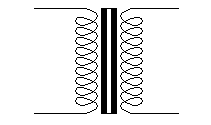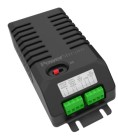24 VAC tutorial
Why 24VAC?
The voltage of 24VAC is primarily used for two purposes:
the first is control, such as in door bells, control panels and thermostats.
The other is to supply operating power, such as in door bells, irrigation
valves, rotation encoders, low voltage lighting systems and CCTV cameras. In
both of these cases the low voltage is used because it is safe and doesn't need
an electrician to wire it, which is not the case for 110VAC or 220VAC circuits.
In addition, lower voltages than 24 would require more amps to supply the same
power, producing more voltage drop through the resistive wires.
But why AC instead of DC? The advantages of AC are lower
cost solenoids and motors, less relay contact erosion and better arc
suppression. AC solenoids are cheaper than DC solenoids. This is because DC
solenoids depend on the resistance of the coil wire to limit their current. AC
solenoids can limit their current by their AC impedance. 24VAC solenoids and
relays do not have the back-EMF problems that DC operated devices have, so
there is less EMI noise.
24VAC can also run longer distances than 12VDC using the
same gauge and length of wire. It isn't because of the alternating current, but
because of the 24V. To supply 24 Watts will require 1 amp at 24VAC and 2 amps
at 12V. The voltage drop in a wire is proportional to only the amps flowing
through it. Losing 1 volt due to ohmic losses in the wire is also more
significant for 12V than for 24V (8% versus 4%).
AC/AC -- The most common source of 24VAC you will
find is the AC/AC wall mount power supply. This is a simple step-down low
voltage transformer, with AC mains voltage input and 24VAC output . It is
inexpensive because there are no other active or passive components (other than
possibly a fuse). But this means that there is limited regulation of the output
voltage. The transformer is designed to give a certain voltage at a certain
current, so often have to be designed specifically for the application. AC/AC
adapters have no line regulation at all, so their output voltage is
proportional to the input voltage. Wall transformers have a small amount of
load regulation, since the transformer windings are a significant part of
the load. 
Since the AC mains voltage can vary, depending on the
distance to the transformer, and the load the transformer sees from you and
your neighbors, the output of a 24VAC transformer will also vary accordingly.
Typical power company specifications for the AC mains are ±10%, so the
output of the 24 VAC transformer will vary from 21.6VAC to 26.4VAC from this
factor alone, because the transformer is not regulated.
24VAC fundamentals Half wave rectification Half wave rectification
 Full wave rectification Full wave rectification
A 24V RMS sine wave has a peak voltage of 33.9 V. When
rectified this results in the pattern shown in the diagram, with peaks of 33.9V
and valleys of 0V. Filtering this pulsed waveform will even this out, but there
will always be some ripple. The output of a 24VAC transformer is not actively
regulated. The transformer is designed to source 24VAC at the nominal current
listed on the label. If you draw more current the voltage will sag, if you draw
less then the voltage will increase. Furthermore, the mains voltage can
typically vary by ±10% depending how far you are from the mains
substation, so even the nominal voltage of the 24VAC transformer can vary
±2.4V. Thus, equipment designed for 24VAC must be relatively flexible in
its acceptable operation voltage. Solenoids and relays actuated by the 24VAC
power are indeed very flexible in their input voltage, as are synchronous
motors.
A synchronous motor is designed to run at the AC frequency
of the source power. The advantages are that the speed is independent of the
load, can be used as timers, have less EMI than brushed DC motors and make
efficient use of available power.
The single diode, half wave rectification DC adapter is
used for the cheapest of battery chargers, toy motors, battery adapters and
other places that the 100% ripple and 50% duty cycle won't matter. Adding a
capacitor can smooth out the ripple, but since it needs a larger capacitor than
full wave bridge rectification, the cost trade off usually leans toward the
full wave rectifier.
An AC/AC transformer has the advantage over switchmode DC
power supplies in that it can supply surge current. For example a sprinkler
valve can have a holding power of 5 watts, but an inrush current of 8 watts.
The transformer will sag in voltage during the inrush pulse, but will not have
to be rated at the higher power.
Running 24VAC relays and solenoids from 24VDC
The magnetic reactance of the relay or solenoid will
regulate the current drawn to open or keep open the magnetic circuit. 24VDC
would rely on only the resistance of the wires. Therefore a 24VAC relay would
overheat when run on 12VDC.
Capacitively coupled noise
Running a twisted pair of 24VAC next to signal wires can
cause trouble. The AC can capacitively couple to the signal wires to add 50Hz
or 60Hz noise to the signal. Moving the signal wires away from the twisted
pair, or shielding the twisted pair will solve the noise problem
Thermostats and HVAC
The 24VAC can be used in HVAC systems to send a signal
from the thermostat to turn on the heat or cooling. It is also sometimes used
to synchronize the thermostat's internal clock and supply power for electronics
and pilot lights. The thermostat turns the unit on by shorting two wires
together, known by the jargon "call." The wiring doesn't usually supply both
lines of the 24VAC power up to the thermostat, but uses one line (Red) which
connects to the correct "call" wire to turn on the heat or cool functions. For
thermostats that require power to operate the other leg of the 24VAC supply can
be run, which is often blue. This is sometimes called the "C" wire, short for
"common," meaning "ground." Some thermostats also try to steal some power from
the "call" wire, but if they steal too much the heater will turn on.
A common multi-stage heat pump system has the following
wiring & connections:
| Description |
Color |
Terminal Code |
|
| 24VAC return |
Red |
RF |
|
| Call for heat |
White |
W1 |
|
| Force fan on |
Green |
GT |
|
| Compressor stage 1 |
Yellow |
Y1 |
|
| Compressor stage 2 |
Not Standardized |
Y2 |
|
| Changeover |
Orange or brown |
C/O, O, or B |
|
ResolversAnother advantage of using 24VAC in your
power distribution is to power "resolvers" which look like a motor, but use the
phase to send back the angle of rotation of the rotor to a controller. Analog
resolvers have high angular resolution, and are robust and dependable shaft
encoders. The windings are designed to create a sine wave output and a cosine
wave output. Comparing these two signals gives an absolute rotation reading.
The zero reading is typically when the sine wave is maximum and the cosine is
minimum. The position is found by taking the ratio of the sine and cosine
winding voltages and taking the arctangent. The ratio makes the reading
inherently immune to noise on the power line, and compensates for variations in
temperature.
Irrigation systems
Many sprinkler systems use 24VAC as a safe way to get AC
power to timers, motors, valves, and solenoids.
Lighting systemsA number of low voltage incandescent
lighting systems have been installed in buildings. They typically run off of
large torroidal transformers, which have multiple input taps to account for
voltage drop at the bulb. A large building might have a closet full of these
torroids.
Solar systems
A solar panel and battery combination are intrinsically
DC. But what if you need AC you have to find a way to invert it. PowerStream has a variety of 24VAC
inverters with 12V, 24V and 48V inputs to allow security cameras, irrigation
systems, etc. to operate off the solar power supply. 
Battery backup
It is often hard to find a good
solution to give a low voltage AC system a battery backup. PowerStream also has
developed a unique 24VAC battery backup. It can be inserted anywhere in a 24VAC
system to charge a battery and supply an uninterruptible 24VAC to devices
downstream.

24VAC to DC converters
There are various
converters available for converting 24VAC to useful DC power. A direction
conversion to 24VDC to run PLCs is available, as are 24VAC to 12VDC converters,
24VAC to 5V converters, and even an adjustable DC output converter for special
applications. In addition we have developed a
fluorescent light ballast series that runs on 24VAC.
|